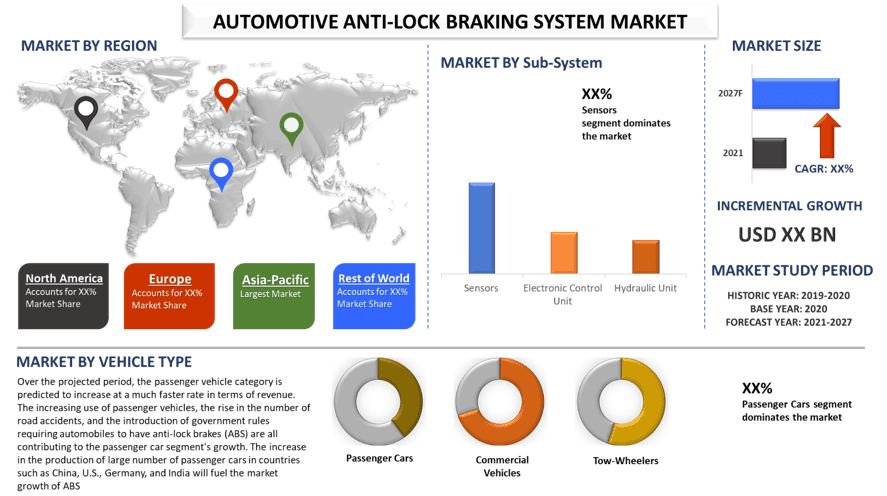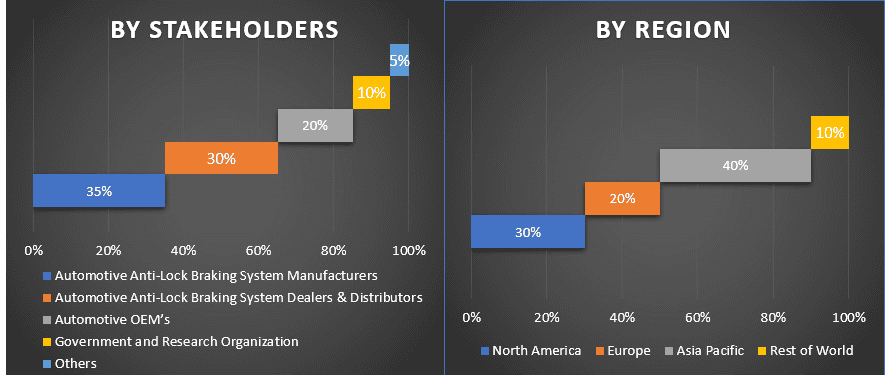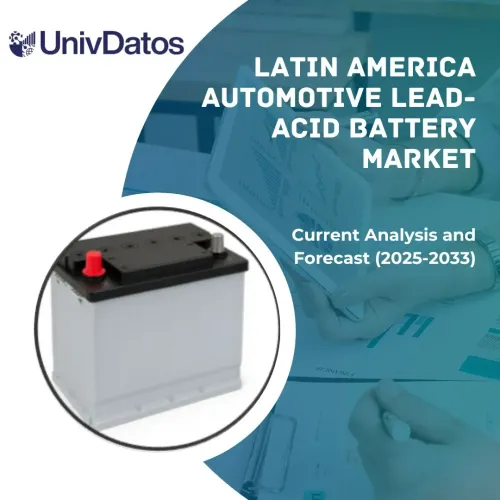- Home
- About Us
- Industry
- Services
- Reading
- Contact Us
Automotive Anti-Lock Braking System Market: Current Analysis and Forecast (2021-2027)
Emphasis on Sub-System (Sensors, Electronic Control Unit and Hydraulic Unit); Vehicle Type (Passenger Car, Commercial Vehicles and Two-Wheeler); Region and Country

Global Automotive Anti-Lock Braking System is anticipated display a CAGR of around ~7% over the forecast period (2021-2027). The rising number of deaths caused by traffic accidents has compelled governments in many countries to implement strict standards and regulations, including the installation of anti-lock brakes (ABS) in all cars, which is propelling the worldwide industry forward. For example, India’s Road Transport Ministry said in September 2015 that by 2018, all motorcycle models shall be equipped with a combined braking system (CBS) and an anti-lock braking system. Aside from letting the driver to preserve the vehicle’s directional stability and steering control when braking, ABS has further benefits. It makes it easier for the automobile to handle sharp curves fast and safely. The current Range Rover, for example, employs the in-built ABS to gradually brake a sliding wheel to assist restore traction and grip. Furthermore, anti-lock braking systems work effectively to bring a vehicle to a rapid stop. Anti-lock braking systems collect turbulent shock waves and modify pulses, enabling the wheel to continue turning while applying maximum braking force. As a result, the use of anti-lock braking systems in self-braking systems is on the rise. However, the worldwide market’s growth is being hampered by irregular stop timings and expensive costs related with these systems.
Insights Presented in the Report
“Amongst Sub-System, Sensors segment dominated the market in 2020”
Based on sub-system, the market is segmented into Sensors, Electronic Control Unit and Hydraulic Unit. The Sensors segment is expected to grow at a higher CAGR during the forecasted period. Sensors are an important aspect of the anti-lock braking system because they help the ABS control module sense, monitor, and communicate wheel speed. This segment’s rapid revenue growth rate may be attributable to technical developments in sensor systems, expanding demand for sophisticated sensors, and increasing vehicle demand.
“Amongst Vehicle Type, Modular segment dominated the market in 2020.”
Based on vehicle type, the market is segmented into Passenger Cars, Commercial Vehicles and Tow-Wheelers. The Passenger Cars segment is expected to grow at a higher CAGR during the forecasted period. Over the projected period, the passenger vehicle category is predicted to increase at a much faster rate in terms of revenue. The increasing use of passenger vehicles, the rise in the number of road accidents, and the introduction of government rules requiring automobiles to have anti-lock brakes (ABS) are all contributing to the passenger car segment’s growth. The increase in the production of large number of passenger cars in countries such as China, U.S., Germany, and India will fuel the market growth of ABS
“Asia Pacific represents as the largest market.”
Based on the estimation, during the projection period of 2021-2027, Asia Pacific market is predicted to be the fastest-growing region in the coming years. During the projection period, it is predicted to dominate with the greatest CAGR. Due to rising vehicle production and sales, Asia Pacific is expected to dominate the automotive anti-lock braking system market. Manufacturers in this region are concentrating their efforts on producing high-end ABS systems in order to attract more customers and get a competitive advantage over their competitors. The key automobile manufacturing countries in the area are India, South Korea, Japan, and China, which are driving the industry forward. Asia-Pacific is one of the world’s fastest-growing regions. Other major drivers driving market revenue growth include rapid urbanization, expanding commercial vehicle usage, rising disposable income, and strong demand for passenger automobiles. Other important reasons driving market expansion include strict government road safety regulations and requirements to install anti-lock brakes (ABS) in cars as a result of an increase in the frequency of road accidents. Some of the major players operating in the market includes Denso Corporation, Robert Bosch GmbH, Hitachi Automotive Systems Ltd., Continental AG, Autoliv Inc., Hyundai Mobis Co., Ltd., ZF Friedrichshafen AG, Aptiv PLC, The Mando Corporation, Nissin Kogyo Co. etc.
Reasons to buy this report:
- The study includes market sizing and forecasting analysis validated by authenticated key industry experts
- The report presents a quick review of overall industry performance at one glance
- The report covers an in-depth analysis of prominent industry peers with a primary focus on key business financials, product portfolio, expansion strategies, and recent developments
- Detailed examination of drivers, restraints, key trends, and opportunities prevailing in the industry
- The study comprehensively covers the market across different segments
- Deep dive regional & country-level analysis of the industry
Customization Options:
The Global Automotive Anti-Lock Braking System can further be customized as per the requirement or any other market segment. Besides this, UMI understands that you may have your own business needs, hence feel free to connect with us to get a report that completely suits your requirements.
Table of Content
The rising number of deaths caused by traffic accidents has compelled governments in many countries to implement strict standards and regulations, including the installation of anti-lock brakes (ABS) in all cars, which is propelling the worldwide industry forward. For example, India’s Road Transport Ministry said in September 2015 that by 2018, all motorcycle models shall be equipped with a combined braking system (CBS) and an anti-lock braking system. Aside from letting the driver to preserve the vehicle’s directional stability and steering control when braking, ABS has further benefits. It makes it easier for the automobile to handle sharp curves fast and safely. The current Range Rover, for example, employs the in-built ABS to gradually brake a sliding wheel to assist restore traction and grip. Furthermore, anti-lock braking systems work effectively to bring a vehicle to a rapid stop. Anti-lock braking systems collect turbulent shock waves and modify pulses, enabling the wheel to continue turning while applying maximum braking force. As a result, the use of anti-lock braking systems in self-braking systems is on the rise. However, the worldwide market’s growth is being hampered by irregular stop timings and expensive costs related with these systems.
Seek More Details About Research Methodology
When compared to traditional brakes, car anti-lock braking systems use distinct mechanics. It brakes with more precision than traditional brakes. The essential component of the ABS is the hydraulic unit, which comprises of an electronic control unit that regulates the brakes at each wheel and a return pump. A wheel-speed sensor is also installed on each wheel, which detects the speed and relays the data to the control unit. If a wheel is going to lock under hard braking, the system decreases the braking pressure on that particular wheel until the risk of locking is eliminated. Once the wheels are turning freely again, the brake pressure is increased again. This cycle of increasing and releasing pressure continues until the driver applies less power to the brake. The anti-lock braking system consists of sensors, an electronic control unit, and a hydraulic unit.
Analysis of Historical Market Size
Step 1: In-Depth Study of Secondary Sources:
Detailed secondary study was conducted to obtain the historical market size of the Automotive Anti-Lock Braking System through company internal sources such as annual report & financial statements, performance presentations, press releases, etc., and external sources including journals, news & articles, government publications, competitor publications, sector reports, third-party database, and other credible publications.
Step 2: Market Segmentation:
After obtaining the historical market size of the Automotive Anti-Lock Braking System, we conducted a detailed secondary analysis to gather historical market insights and share for different segments & sub-segments for major regions. Major segments included in the report are by sub-system, vehicle type. Further regional & country-level analyses were conducted to evaluate the overall adoption of the Automotive Anti-Lock Braking System in the global context.
Step 3: Factor Analysis:
After acquiring the historical market size of different segments and sub-segments, we conducted a detailed factor analysis to estimate the current market size. Further, we conducted factor analysis using dependent and independent variables such as growing government incentives and demand for eco-friendly transportations etc. Historical trends and their year-on-year impact on the market size and share was analyzed. Demand and supply side scenario was also thoroughly studied.
Current Market Size Estimate & Forecast
Current Market Sizing: Based on actionable insights from the above 3 steps, we arrived at the current market size, key players in the Market, and market shares of the segments and company. All the required percentage split, and market breakdowns were determined using the above-mentioned secondary approach and were verified through primary interviews.
Estimation & Forecasting: For market estimation and forecast, weights were assigned to different factors including drivers & trends, restraints, and opportunities available for the stakeholders. After analyzing these factors, relevant forecasting techniques i.e., bottom-up approach was applied to arrive at the market forecast to 2027 for different segments and subsegments across the major regions globally. The research methodology adopted to estimate the market size encompasses:
- The industry’s market size, in terms of value (US$) and the adoption rate of Automotive Anti-Lock Braking System across the major markets
- All percentage shares, splits, and breakdowns of market segments and sub-segments
- Key players in the Automotive Anti-Lock Braking System in terms of products offered. Also, the growth strategies adopted by these players to compete in the fast-growing market.
Market Size and Share Validation
Primary Research: In-depth interviews were conducted with the Key Opinion Leaders (KOLs) including Top Level Executives (CXO/VPs, Sales Head, Marketing Head, Operational Head, and Regional Head, Country Head, etc.) across major countries. Primary research findings were then summarized, and statistical analysis was performed to prove the stated hypothesis. Inputs from primary research were consolidated with secondary findings, hence turning information into actionable insights.
Split of Primary Participants in Different Regions

Market Engineering
Data triangulation technique was employed to complete the overall market estimation and to arrive at precise statistical numbers of each segment and sub-segment of the Automotive Anti-Lock Braking System. Data was split into several segments & sub-segments post studying various parameters and trends in the areas of service type, vehicle type, and region.
The main objective of the Automotive Anti-Lock Braking System Study
The current & future market trends of Automotive Anti-Lock Braking System were pinpointed in the study. Investors can gain strategic insights to base their discretion for investments from the qualitative and quantitative analysis performed in the study. Current and future market trends would determine the overall attractiveness of the market at a regional & country level, providing a platform for the industrial participant to exploit the untapped market to benefit as a first-mover advantage. Other quantitative goals of the studies include:
- Analyze the current and forecast market size of Automotive Anti-Lock Braking System in terms of value (US$). Also, analyze the current and forecast market size of different segments and sub-segments
- Segments in the study include sub-system and vehicle type
- Defined analysis of the regulatory framework for the Global Automotive Anti-Lock Braking System industry
- Analyze the value chain involved with the presence of various intermediaries, along with analyzing customer and competitor behaviors of the industry
- Analyze the current and forecast market size of the Automotive Anti-Lock Braking System for the major regions & countries
- Major regions studied in the report include North America (US, Canada, Rest of North America), Europe (Germany, United Kingdom, France, Italy, Rest of Europe), Asia Pacific (China, Japan, India, South Korea, Rest of Asia-Pacific), and Rest of World
- Company profiles of the Automotive Anti-Lock Braking System players and the growth strategies adopted by them to sustain in the fast-growing market
Deep dive regional & country level analysis of the industry
Related Reports
Customers who bought this item also bought










